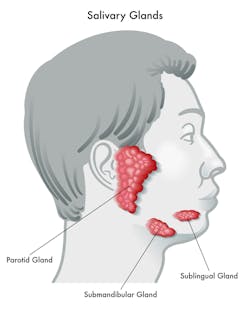As my research began taking me down the usual rabbit hole, I found an interesting theory related to the history of salivary diagnostics. Interesting to me, at least in part because of the name, in ancient China, “The Rice Test” theory held that a person’s inability or perceived difficulty to swallow a mouthful of rice signaled guilt. The idea was that the guilty party’s failure to form a bolus of dry rice was because of anxiety and presumed guilt that in turn inhibited the saliva production necessary for the formation of the food bolus and swallowing.1 So, did this dry mouth phenomenon lead to modern-day salivary diagnostics? It seems like a reach to get to where we are today, but the folktale does make for a good story.
History shows that as early as 1685, saliva was being tested using mercury. Then, in 1808, the acidity of saliva was being tested, and in 1836 there’s record of saliva testing on bronchitis patients.2–5 The advancements of salivary diagnostics over the last 20 years has been nudged along by investments from the National Institute of Dental Research (NIDCR) of the National Institutes of Health (NIH). They put engineers and oral biology researchers together who then collaborated to develop point-of-care (POC) diagnostic tools.6,7 Salivary science has swung open the door for the clinical diagnosis of oral and systemic diseases significantly.
What is saliva?
Saliva is a biological fluid composed of more than 99% water and less than 1% proteins, electrolytes, and other low-molecular-weight components.8 Remember, it mainly comes from three pairs of major salivary glands (figure 1): the parotid, submandibular, and sublingual, not forgetting the 300-400 minor salivary glands of the oral cavity (which, thankfully, I never had to memorize).9 Gingival crevicular fluid contains bacteria, epithelial cells, erythrocytes, leukocytes, and food debris, contributing only in small part to the formation of oral fluids. Saliva plays a key role in lubrication, mastication, swallowing, and digestion, protecting the integrity of the oral tissues, but it also provides clues for local and systemic diseases and conditions.10 Molecules such as DNAs, RNAs, proteins, metabolites, and microbiota, present in blood, could be also present in saliva.
Salivary diagnostics
Someone coined the phrase “salivaomics” as a broad collection of technologies used to explore different types of molecules contained in saliva. This term includes genome and epigenome (the study of genes and their methylation), transcriptomics (the study of mRNA within cells
or organisms), metabolomics (the study of global metabolite profiles in a system), proteomics (the study of proteins), and microbiology (the study of microscopic organisms).
Salivary testing aids in the assessment and diagnosis of a host of diseases and propensity to a disease. In medicine, it’s common to check hormonal levels such as cortisol, estrogen, and testosterone as markers of illness; similarly, salivary biomarkers can be detected upon the development of systemic cancers such as pancreatic, breast, lung, or ovarian cancers.11–13 They can be used to screen for Cushing’s and Addison’s diseases, and even saliva nitrite, a biomarker for nitric oxide status, which has a role in cardiovascular protection.
I took a salivary test to find out my apolipoprotein (APOE) variant, which is a risk factor for late-onset Alzheimer’s disease. There are many viruses in oral samples that can be detected by using an antigen, an antibody, or nucleic acid targets. There can also be detection of HIV and hepatitis C (HCV). At this juncture, I wouldn’t say that dentistry has moved into these arenas, but the potential is there.
Application in dentistry
Several companies offer services to check for specific periodontal pathogens, caries risk pathogens, gene markers related to inflammatory response, and even fungus. They can detect anywhere from the top five high-risk pathogens to upwards of 15. Candida may coaggregate with bacteria in biofilm and adhere to epithelial cells. One company in particular tests what’s inside the periodontal pocket using paper points. This gives an exact insight so that the clinician can create specific treatment protocols based on the pathogen inside a diseased area. Physicians regularly use objective tests to guide treatment plans and follow-up tests to see if the treatment prescribed is working. Dentistry has an opportunity to improve old, subjective methods of analysis by using salivary diagnostics that will hold objective answers.
Technology
Some companies use quantitative polymerase change reaction (qPCR) technology, which is a quick way to identify pathogens and antimicrobial resistance markers. It amplifies target DNA to levels at which a detectable signal can be observed. qPCR is great if you want to know the quantity of a set of specific bacteria. Others use qPCR+ next generation DNA sequencing (NGS). NGS is just the actual machine used for sequencing DNA. When using NGS, we can analyze the genetic fingerprint of everything in the sample. Depending on the company’s database, a sample can be matched against tens of thousands of possible microbial DNA matches and can identify antibiotic resistance genes found in the samples. You may have heard of 16s, which is yet another method of NGS. Finally, a new company offers shotgun metagenomic sequencing, which can sample all genes in all organisms present in each complex sample. Traditionally more expensive, shotgun metagenomic sequencing allows for an evaluation of bacterial diversity and detects the abundance of microbes in various environments. It also provides a means to study unculturable microorganisms that are otherwise difficult or impossible to analyze and is better at detecting low abundance species than 16s.
As a closet private detective, I enjoy the opportunity to figure out what’s lurking in my patients’ saliva, and then treating those microbes with increased accuracy and success.
Editor's note: This article appeared in the June 2022 print edition of RDH magazine and has been updated as of October 2024. Dental hygienists in North America are eligible for a complimentary print subscription. Sign up here.
References
- Ogbureke KUE, Ogbureke EI. The history of salivary diagnostics. In: Streckfus C, ed. Advances in Salivary Diagnostics. Springer, Berlin, Heidelberg; 2015. https://doi.org/10.1007/978-3-662-45399-5_2
- de Blégny N. Zodiacus Medico-Gallicus, sive miscellaneorum curiosorum, medico-physicorum sylloge. Vol. 5. Chouët; 1685:149.
- Nicholson W. A Dictionary of Practical and Theoretical Chemistry: With Its Application to the Arts and Manufactures, and to the Explanation of the Phaenomena of Nature... : with Plates and Tables. Richard Phillips; 1808:2.
- The Medico-chirurgical Review and Journal of Practical Medicine. Johnson J, Johnson HJ, eds. Vol. 24. Richard & George S. Wood; 1836:231, 233.
- Medicine: Saliva Testing. HandWiki. https://handwiki.org/wiki/Medicine:Saliva_testing
- Zhang CZ, Cheng XQ, Li JY, et al. Saliva in the diagnosis of diseases. Int J Oral Sci. 2016;8(3):133-137. doi:10.1038/ijos.2016.38
- Segal A, Wong DT. Salivary diagnostics: enhancing disease detection and making medicine better. Eur J Dent Educ. 2008;12 Suppl 1(Suppl 1):22-29. doi:10.1111/j.1600-0579.2007.00477.x
- Soini HA, Klouckova I, Wiesler D, et al. Analysis of volatile organic compounds in human saliva by a static sorptive extraction method and gas chromatography-mass spectrometry. J Chem Ecol. 2010;36(9):1035-1042. doi:10.1007/s10886-010-9846-7
- Aps JK, Martens LC. Review: The physiology of saliva and transfer of drugs into saliva. Forensic Sci Int. 2005;150(2-3):119-131. doi:10.1016/j.forsciint.2004.10.026
- Slavkin HC. Toward molecularly based diagnostics for the oral cavity. J Am Dent Assoc. 1998;129(8):1138-1143. doi:10.14219/jada.archive.1998.0390
- Zhang L, Farrell JJ, Zhou H, et al. Salivary transcriptomic biomarkers for detection of resectable pancreatic cancer. Gastroenterol. 2010;138(3):949-57.e577. doi:10.1053/j.gastro.2009.11.010
- Agha-Hosseini F, Mirzaii-Dizgah I, Rahimi A. Correlation of serum and salivary CA15-3 levels in patients with breast cancer. Med Oral Patol Oral Cir Bucal. 2009;14(10):e521-e524. doi:10.4317/medoral.14.e521
- Li X, Yang T, Lin J. Spectral analysis of human saliva for detection of lung cancer using surface-enhanced Raman spectroscopy. J Biomed Opt. 2012;17(3):037003. doi:10.1117/1.JBO.17.3.037003








